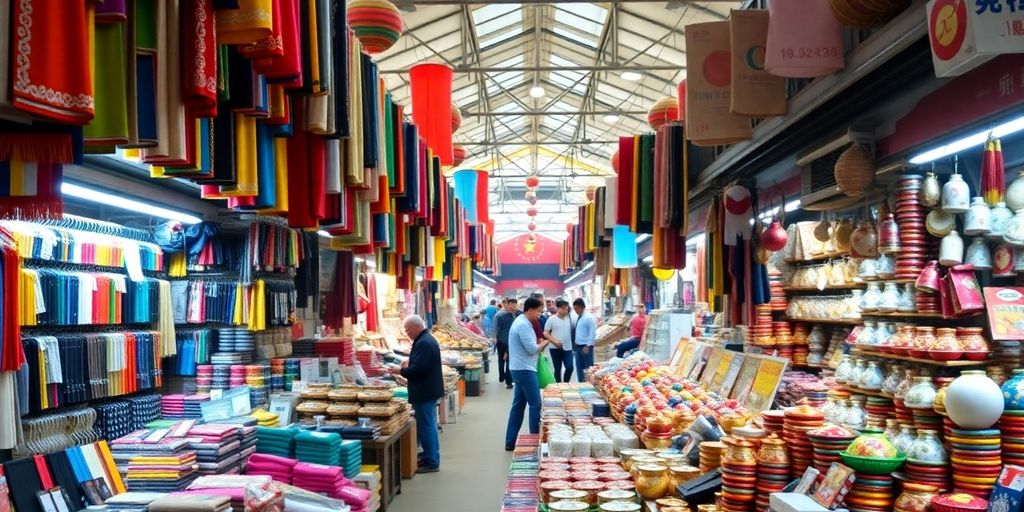Importar productos al por mayor de China puede parecer una tarea desalentadora, pero con el enfoque adecuado, puede ser una empresa rentable. La enorme capacidad de fabricación de China permite encontrar casi cualquier producto a precios competitivos. Sin embargo, para adentrarse en este mundo es necesario conocer el mercado, los proveedores y la logística. Tanto si es nuevo en el mundo de la importación como si desea perfeccionar su estrategia, esta guía le proporcionará los conocimientos esenciales para triunfar.
Principales conclusiones
- La investigación es crucial. Dedique tiempo a conocer el mercado y encontrar proveedores fiables.
- Elija productos que tengan demanda pero que no estén sobresaturados en el mercado.
- Establecer relaciones sólidas con los proveedores para garantizar transacciones fluidas.
- Comprender y respetar la cultura empresarial china para negociar mejor.
- Verifique siempre la calidad y la conformidad del producto para evitar problemas legales.
Aspectos básicos de la importación de productos al por mayor de China
Por qué elegir China para la venta al por mayor
Muchos vendedores optan por comprar a Proveedores chinos principalmente por la bajada de precios, impulsada por salarios más bajos y materiales más accesibles en China. El poderío manufacturero de China es inigualable, ya que ofrece una amplia gama de productos a precios competitivos. Ya sean productos electrónicos, textiles o artículos para el hogar, la variedad es inmensa. Además del ahorro de costes, la rapidez de la producción y la innovación en China es otra de las razones por las que los importadores acuden allí en masa.
Consideraciones clave antes de empezar
Antes de lanzarse a importar de China, hay que tener en cuenta varios factores clave:
- Investigue el mercado: Dedique tiempo a comprender qué productos tienen demanda y qué nichos están desatendidos.
- Verificación de proveedores: Asegúrese de la credibilidad de sus proveedores para evitar estafas. Compruebe las reseñas, solicite muestras y verifique sus licencias comerciales.
- Análisis de costes: No se fije sólo en el precio del producto. Tenga en cuenta los gastos de envío, los aranceles y las posibles tasas aduaneras.
Conceptos erróneos sobre las importaciones chinas
Hay algunos mitos sobre la importación de China que es necesario desmentir:
- Preocupación por la calidad: Aunque algunos creen que los productos chinos son de baja calidad, muchos proveedores ofrecen productos de alta calidad. Se trata de elegir al proveedor adecuado.
- Complejidad de la importación: El proceso puede parecer desalentador, pero con la orientación y la preparación adecuadas, es manejable.
- Todos los productos son falsos: Aunque existen falsificaciones, muchos productos auténticos y originales se fabrican en China. Es crucial conocer las fuentes.
Cómo encontrar los productos adecuados para importar de China

Identificar nichos rentables
Elegir el nicho adecuado es como encontrar una aguja en un pajar, pero con la estrategia adecuada, se puede conseguir. Centrarse en nichos de mercado que no estén saturados por grandes minoristas como Amazon o Walmart. Esto significa buscar productos que sean únicos o que tengan una competencia limitada. Herramientas como "Best Sellers" y "Movers and Shakers" de Amazon pueden ayudarle a detectar tendencias y descubrir productos emergentes. También puedes utilizar Alibaba para explorar diferentes categorías y ver qué es popular. No pierdas de vista los artículos especializados que responden a intereses o necesidades específicos.
Evitar los productos de alto riesgo
A la hora de importar, no todos los productos son iguales. Evite los productos que puedan causar lesiones o que tengan requisitos de cumplimiento estrictos, ya que pueden acarrearle quebraderos de cabeza legales. Los productos de alto riesgo suelen incluir cualquier cosa que pueda dañar potencialmente a los usuarios, como aparatos electrónicos con problemas de seguridad o juguetes con piezas pequeñas. En su lugar, busque artículos sencillos, seguros y fáciles de importar.
Principales categorías de productos
Si se pregunta qué importar, empiece por estas categorías:
- Decoración del hogar: Artículos como el arte mural o los cojines decorativos pueden ser muy populares.
- Accesorios de moda: Piensa en gafas de sol o pañuelos.
- Suministros para mascotas: Siempre hay demanda de productos para dueños de mascotas.
Estas categorías suelen tener una demanda constante y pueden ser un buen punto de partida para identificar productos de gran demanda y baja competencia importar. Tenga siempre en cuenta los gastos de envío y las posibilidades de etiquetado privado para crear una identidad de marca única.
Selección de proveedores chinos fiables
Cómo verificar las credenciales de los proveedores
Encontrar un proveedor de confianza en China es como encontrar una aguja en un pajar, pero no es imposible. La verificación es clave. Empiece por comprobar si el proveedor es un "proveedor de oro" en plataformas como Alibaba. Este distintivo indica que han pagado por una membresía premium y han pasado controles básicos. Pero no se detenga ahí. Busque verificaciones de terceros. Estos servicios, aunque cuestan un poco, pueden confirmar si las operaciones de un proveedor son legítimas. Además, busque en Google el nombre del proveedor para ver su presencia en Internet. Un sitio web y un historial sólidos pueden decirte mucho.
Establecer relaciones sólidas con los proveedores
Construir una relación con su proveedor es como cualquier otra relación: requiere tiempo y esfuerzo. No se limite a los correos electrónicos; coja el teléfono o, mejor aún, si puede, reúnase en persona. Las reuniones cara a cara pueden ayudar a establecer la confianza. Deja claras tus expectativas y comunícate con regularidad. No ponga todos los huevos en la misma cesta. Es inteligente tener un proveedor de reserva por si las cosas se tuercen con el principal.
Señales de alarma
Not all suppliers are what they seem. Watch for red flags like inconsistent communication or reluctance to provide samples. If a supplier can’t give you a sample, that’s a big warning sign. Also, if their prices are too good to be true, they probably are. Check their physical address and client references. You want to make sure they are who they say they are. If something feels off, trust your gut and walk away.
Navigating Chinese Business Culture
In China, business is all about hierarchy. It’s not just about who is in charge but knowing the pecking order can make a huge difference. When you step into a meeting room, you should know who the top dog is and greet them first. Forget about using first names; stick to titles and last names. And remember, a firm handshake might be seen as too aggressive, so keep it light and short.
Estrategias de comunicación eficaces
Communication in Chinese business culture is a bit of an art. Subtlety is key. Asking direct questions can make things awkward, so you need to learn to read between the lines. If you have a complaint or need to discuss a problem, it’s best to do it indirectly. Instead of pointing fingers, talk about how things can be improved. This approach is more likely to get you the results you want.
The Importance of Face-to-Face Meetings
Meeting in person can really set the tone for your business relationship. Sure, it’s not always possible, but if you can swing a trip to China, it’s worth it. Face-to-face meetings help build trust and show your commitment. Plus, you get to experience the local culture firsthand, which can be a game-changer in understanding your business partners better. If you visit places like the Yiwu International Market, you’ll get a feel for the vast array of products and the bustling business environment. So, make it a point to go there, shake hands, and maybe share a meal. It’s all about building those personal connections that can make or break your business deals.
Gestión de logística y envíos

Elegir el método de envío adecuado
Picking the right shipping method is like setting the foundation for your import business. You have a few options: air freight, sea freight, and courier services. Each has its own pros and cons. For instance, air freight is quick but can be pricey, while sea freight is more affordable but takes longer. Couriers are great for small, urgent shipments but might not be cost-effective for larger loads. Consider your budget, time constraints, and the nature of your goods when choosing.
Understanding Customs and Tariffs
Dealing with customs and tariffs is unavoidable when importing from China. It’s important to know the rules and regulations of both China and your home country. You’ll need to prepare the right documents, like commercial invoices and packing lists, to ensure a smooth customs process. Also, be aware of the tariffs that might apply to your products. These can vary based on product category and destination country. Getting familiar with these can save you from unexpected costs.
Tips for Reducing Shipping Costs
Shipping can eat into your profits if you’re not careful. Here are some tips to keep those costs down:
- Consolidate shipments: Combine smaller shipments into one larger one to save on costs.
- Negotiate with carriers: Don’t be afraid to haggle for better rates, especially if you’re shipping regularly.
- Use a freight forwarder: They can often secure better rates and help with logistics.
Managing logistics isn’t just about moving products; it’s about doing it efficiently and cost-effectively. By understanding your options and planning ahead, you can keep your shipping costs manageable and your business running smoothly.
Ensuring Product Quality and Compliance
Conducting Quality Inspections
When you’re importing goods from China, making sure your products are up to snuff is a big deal. Quality inspections are your best friend here. You can hire third-party inspection companies to check your products before they ship. This step helps catch any issues early, saving you from headaches later. Here are some things to consider:
- Inspección previa a la producción: This checks raw materials and components before manufacturing starts.
- Durante la inspección de la producción: Conducted when 20-50% of the production is complete, ensuring things are on track.
- Inspección previa al envío: Before the goods leave the factory, this final check ensures everything meets your standards.
Understanding Compliance Requirements
Each country has its own set of rules for importing goods. You need to know what certifications and standards your products must meet. For example, electronics might need a CE mark if you’re selling in Europe. Product certification is crucial to avoid any legal trouble and ensure safety. Here’s what you should do:
- Research the specific compliance requirements for your product category.
- Verify that your supplier can meet these standards.
- Obtain all necessary certifications before the products are shipped.
Dealing with Product Defects
No matter how careful you are, defects can still pop up. Having a plan in place is key. Start by negotiating clear terms with your supplier about handling defects. This could include:
- Replacement Policy: Agree on how defective products will be replaced or refunded.
- Documentación: Keep detailed records of all communications and agreements.
- Regular Audits: Perform regular audits of your supplier to ensure ongoing compliance and quality.
Ensuring product quality and compliance isn’t just about avoiding problems—it’s about building trust with your customers and creating a reliable brand. Taking these steps seriously can lead to long-term success in your importing business.
Negotiating Prices and Payment Terms
Strategies for Price Negotiation
When it comes to negotiating prices with Chinese suppliers, it’s all about the dance. Start by low-balling your first counteroffer. This sets the stage for a better deal. Suppliers often expect this, so don’t worry about offending them. It’s part of the game. Also, consider ordering larger quantities. Suppliers might offer discounts for bulk purchases, which can significantly cut costs in the long run. But remember, don’t commit to more than you can sell.
Understanding Payment Options
Navigating payment options can be tricky. While many suppliers prefer Telegraphic Transfer (T/T), you might want to suggest using PayPal for smaller transactions. It’s safer and offers some buyer protection. However, for larger orders, T/T is standard, with a typical 30% upfront and 70% before shipment. Always discuss terms clearly and consider asking for a smaller upfront deposit to minimize risk.
Managing Currency Exchange Risks
Currency exchange can eat into your profits if you’re not careful. Keep an eye on exchange rates and consider locking in a rate if it looks favorable. Some businesses use forward contracts to hedge against currency fluctuations, ensuring they know exactly what they’ll pay. It’s also wise to have a buffer in your budget to account for any unexpected changes in rates.
Negotiating with Chinese suppliers isn’t just about getting the lowest price. It’s about building a relationship where both parties feel they are getting a fair deal. This balance will serve you well in the long term.
Marketing and Selling Your Imported Goods
Crear una identidad de marca fuerte
Building a brand isn’t just about having a fancy logo or a catchy tagline. It’s about creating a unique story that connects with your audience. Start by defining what makes your product special and why your customers should care. Your brand identity should reflect your values and resonate with your target audience.
- Know Your Audience: Understand who your customers are and what they need.
- Consistent Messaging: Keep your brand voice consistent across all platforms.
- Visual Appeal: Ensure your packaging and product design stand out.
Effective Online Marketing Strategies
Selling online requires more than just listing your products on a website. You need to actively engage with potential buyers and drive traffic to your listings.
- Utilize Social Media: Platforms like Instagram and Facebook are great for reaching a broad audience. Share engaging content and interact with your followers.
- Marketing por correo electrónico: Build an email list and send regular updates, promotions, and news to keep your customers informed.
- Optimize for Search Engines: Use SEO strategies to make sure your products appear in search results. This includes using relevant keywords and creating quality content.
Building a Loyal Customer Base
Having repeat customers is crucial for long-term success. It’s often cheaper to retain customers than acquire new ones.
- Excellent Customer Service: Respond promptly to inquiries and resolve issues quickly.
- Loyalty Programs: Offer discounts or rewards for repeat purchases.
- Retroalimentación y mejora: Listen to customer feedback and continuously improve your products and services.
In the world of importing and selling, your ability to connect with your customers can make or break your business. It’s not just about the products; it’s about the relationships you build along the way. Prioritize customer satisfaction, and you’ll see your business thrive.
Consideraciones jurídicas y éticas
Normativa sobre importación
Before you start importing goods from China, it’s important to understand local import requirements. These rules can vary widely depending on the type of product and the country you’re importing into. Not knowing the rules might lead to delays, fines, or worse, confiscation of your goods. It’s smart to check with local authorities or a legal advisor to make sure you’re on the right track.
Avoiding Counterfeit Products
Counterfeit goods are a big issue when importing from China. You need to be sure that the products you’re buying are legit and not knock-offs. This means doing your homework on the supplier and checking their credentials. If you get caught selling fake goods, you could face legal trouble and damage your reputation.
Ensuring Ethical Sourcing
When you’re importing, it’s not just about the goods themselves but also how they’re made. Ethical sourcing is about making sure that the workers who produce your products are treated fairly and work in safe conditions. This can be a selling point for your customers who care about where their products come from. Make sure to ask your suppliers about their labor practices and look for certifications that prove ethical standards.
Remember, taking the time to understand the legal and ethical landscape of importing can save you from headaches down the road. It might seem like a hassle, but it’s worth it to keep your business running smoothly and ethically.
Scaling Your Import Business
When to Expand Your Product Line
Figuring out when to add new products can be a bit tricky. You don’t want to jump the gun, but you also don’t want to miss out on opportunities. A good rule of thumb is to expand when your current products are consistently selling well and your operations are smooth. Look at market trends and customer feedback to identify gaps you can fill. Keep an eye on your competitors too. If they’re expanding, it might be time for you to consider it as well.
Managing Increased Order Volumes
Handling more orders is exciting but can be overwhelming. It’s crucial to have systems in place to deal with the extra workload. Consider automating parts of your process like order fulfillment and inventory management. This can help you keep up without needing to hire a ton of new staff. It’s also wise to explore international expansion as a way to grow your business and reach new customers.
Leveraging Technology for Growth
Technology is your friend when it comes to scaling. Use software to streamline operations and gather data on sales and inventory. This info can help you make smarter decisions about what to stock and where to focus your efforts. Consider using e-commerce platforms that offer built-in tools for managing your business. These can save you a lot of time and headaches.
Scaling a business isn’t just about selling more; it’s about doing more with less. Focus on efficiency and smart growth strategies to make the most of your resources.
If you’re looking to grow your import business, now is the perfect time to take action! At Aeonix Trade, we offer tailored solutions to help you navigate the complexities of global sourcing. Don’t miss out on the chance to connect with reliable suppliers and streamline your operations. Visit our website today to learn more and start your journey towards success!
Conclusión
So, there you have it, the ins and outs of importing wholesale goods from China. It might seem like a lot to take in, but once you get the hang of it, it’s pretty straightforward. Remember, the key is to do your homework and build solid relationships with your suppliers. Don’t rush the process; take your time to understand the market and the products you want to bring in. And hey, don’t be afraid to start small and grow from there. With patience and persistence, you can turn importing into a profitable venture. Good luck on your journey!
Preguntas frecuentes
Why should I consider importing from China?
China is known as the world’s factory, offering a wide range of products at competitive prices. This makes it an attractive option for businesses looking to import goods and make a profit.
What are some common myths about importing from China?
Many people think all Chinese products are low quality, but this isn’t true. With the right supplier, you can find high-quality goods. Another myth is that importing is too complicated, but with proper research, it can be straightforward.
How do I find the right products to import?
Start by researching market trends and identifying profitable niches. Focus on products that are in demand but not oversaturated in the market.
What should I look for in a Chinese supplier?
Look for suppliers with a good reputation, verified credentials, and positive customer reviews. It’s also important to establish a strong relationship and communicate clearly with them.
How can I ensure the quality of the products I import?
Conduct quality inspections and request samples before placing large orders. This helps you verify the product’s quality and make necessary adjustments.
What is important to know about Chinese business culture?
Understanding hierarchical structures and effective communication is key. Face-to-face meetings are often valued, and building trust is crucial for successful business relationships.
How can I manage shipping and logistics efficiently?
Choose the right shipping method based on cost and delivery time. Familiarize yourself with customs and tariffs to avoid delays, and consider hiring a customs broker if needed.
What are some tips for negotiating prices with suppliers?
Be prepared with market research to support your price requests. Understand different payment options and be aware of currency exchange risks when negotiating terms.





